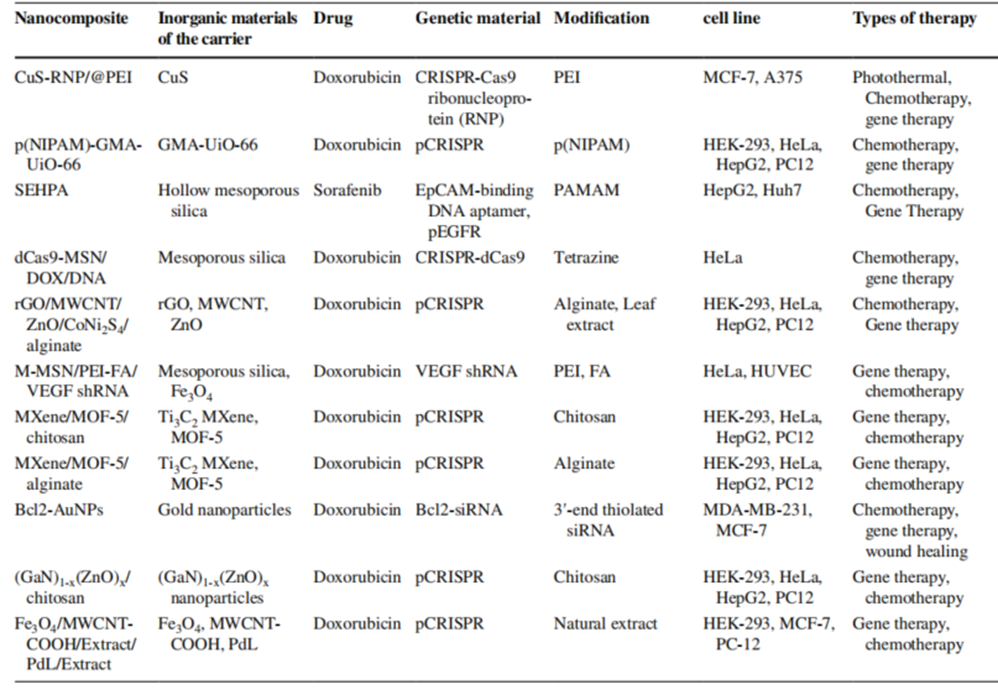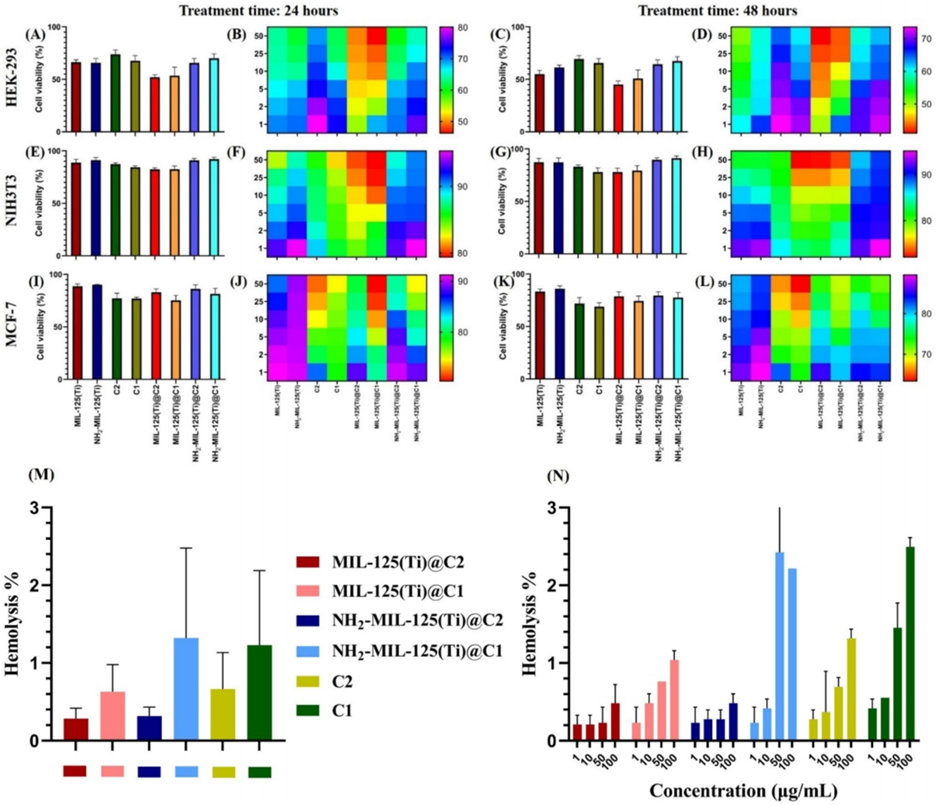Editor: Tiffany
Researchers have developed an innovative nanocomposite that significantly improves the targeted delivery of both chemotherapy drugs and gene therapy to cancer cells, potentially reducing side effects and enhancing treatment efficacy.
Key Highlights
- Research Question:
How can the efficiency and specificity of delivering therapeutic agents to cancer cells be improved while minimizing side effects on healthy tissues? - Research Difficulties:
Creating a delivery system that can simultaneously carry a chemotherapy drug and a gene-editing tool, ensuring targeted delivery to cancer cells, and enhancing cellular uptake and transfection efficiency. - Key Findings:
The (NH₂)-MIL-125(Ti)/poly(aniline-co-para-phenylenediamine)/MnFe₂O₄ nanocomposite achieved 75.4% drug loading, 38.3% increased cellular uptake, and 38.3% gene transfection efficiency in A549 cells. - Innovative Aspects:
Utilization of amine-functionalized metal-organic frameworks for improved cellular interaction, integration of a copolymer and magnetic nanoparticles for multifunctional capabilities, and employment of a cell-imprinted substrate to enhance delivery in a physiologically relevant environment. - Importance of the Study:
Provides a promising platform for combination cancer therapy, potentially leading to more effective treatments with reduced side effects, and sets the stage for further research in targeted drug and gene delivery.
Challenges in Current Cancer Treatments
Cancer remains one of the most significant global health challenges, affecting millions of individuals annually. It is defined by the uncontrolled proliferation of abnormal cells, which can invade adjacent tissues and metastasize to distant sites. Symptoms vary widely depending on cancer type and location, commonly including unexplained weight loss, persistent fatigue, pain, and detectable masses or swelling. Despite progress in medical interventions, cancer persists as a leading cause of mortality worldwide.
Current therapeutic strategies for cancer encompass surgery, radiation therapy, and chemotherapy. Chemotherapy, a cornerstone of treatment, employs drugs like doxorubicin (DOX) to eradicate cancer cells. However, its efficacy is hampered by significant limitations, including non-specific targeting that results in collateral damage to healthy tissues. This leads to adverse effects such as nausea, alopecia, and heightened infection susceptibility. Moreover, inefficient delivery mechanisms diminish the proportion of drug reaching the tumor, underscoring the need for innovative solutions. This research introduces a nanocomposite designed to enhance the precision and effectiveness of drug and gene delivery, offering a potential breakthrough in cancer therapy.
Designing a Nanocomposite for Dual Drug and Gene Delivery
The study aimed to tackle the inefficiencies and toxicities inherent in conventional cancer treatments, with a focus on chemotherapy. The researchers sought to engineer a sophisticated delivery system capable of simultaneously transporting DOX, a chemotherapeutic agent, and pCRISPR, a gene-editing tool, directly to cancer cells. This dual-delivery approach was intended to improve targeting accuracy, mitigate systemic toxicity, and elevate therapeutic efficacy.
The specific objectives included:
- Synthesizing a nanocomposite integrating amine-functionalized metal-organic frameworks ((NH₂)-MIL-125(Ti)), a copolymer (poly(aniline-co-para-phenylenediamine)), and manganese ferrite (MnFe₂O₄) nanoparticles.
- Assessing the nanocomposite’s capacity to co-deliver DOX and pCRISPR to cancer cells.
- Investigating the impact of amine functionalization on cellular uptake and transfection efficiency.
- Evaluating the system’s therapeutic potential using a cell-imprinted substrate to replicate the cellular microenvironment.
The research was spearheaded by Moein Safarkhani from the Department of Biological Sciences and Bioengineering at Inha University, South Korea, with contributions from collaborators at Sharif University of Technology, Iran, and other institutions. The findings were published in Advanced Composites and Hybrid Materials in January 2024.
Synthesis and Performance of the Nanocomposite
The researchers adopted a rigorous experimental framework to synthesize and evaluate the nanocomposite. Below is an outline of the methodology and key outcomes.
Overall Experimental Approach
- Nanoparticle Synthesis: Manganese ferrite (MnFe₂O₄) nanoparticles were prepared via an in situ co-precipitation method.
- Polymer-Based Nanocomposites: Two variants, poly(para-phenylenediamine)@MnFe₂O₄ (C1) and poly(aniline-co-para-phenylenediamine)@MnFe₂O₄ (C2), were synthesized using in situ copolymerization.
- MOF Fabrication: MIL-125(Ti) and its amine-functionalized derivative, (NH₂)-MIL-125(Ti), were produced through solvothermal techniques.
- Composite Assembly: The polymer-based nanocomposites (C1 and C2) were integrated with the MOFs to form the final structures.
- Loading and Testing: DOX was incorporated into the nanocomposites, and pCRISPR was surface-decorated, followed by in vitro assessments of delivery performance.
Key Experiments
Experiment 1: Drug Loading Efficiency
- Procedure: Nanocomposites were incubated with DOX at varying ratios, and loading was quantified via UV-Vis spectroscopy.
- Result: The (NH₂)-MIL-125(Ti)@C2 nanocomposite achieved a peak loading efficiency of 75.4%.
- Finding: Amine functionalization markedly enhanced drug encapsulation capacity.

Table 1. Some of the studies which have been assessed gene/drug co-delivery.
Experiment 2: Cellular Uptake Studies
- Procedure: Cellular internalization was assessed in A549 cancer cells using fluorescence microscopy.
- Result: The (NH₂)-MIL-125(Ti)@C1 nanocomposite exhibited a 38.3% increase in uptake compared to non-functionalized counterparts.
- Finding: Amine modification significantly improved cellular penetration.
Experiment 3: Gene Transfection Efficiency
- Procedure: pCRISPR-loaded nanocomposites were evaluated for transfection in A549 cells, with efficiency measured by green fluorescent protein (GFP) expression.
- Result: The (NH₂)-MIL-125(Ti)@C1 nanocomposite recorded a transfection efficiency of 38.3%.
- Finding: Amine-functionalized systems demonstrated superior gene delivery performance.

Figure 1. The 2D fuorescence images of pCRISPR and GFP-loaded non-viral vectors transfected the A549 cell line.
Experiment 4: Therapeutic Efficacy with Cell-Imprinted Substrate
- Procedure: A cell-imprinted substrate was employed to simulate the cellular environment, and gene delivery was assessed via fluorescence imaging.
- Result: The (NH₂)-MIL-125(Ti)@C1 nanocomposite displayed the highest fluorescence intensity, indicating enhanced gene expression.
- Finding: The cell-mimetic substrate amplified the nanocomposite’s therapeutic effectiveness.

Figure 2. The MTT assay on various cell lines (24 and 48 h treatment).
Implications for Future Cancer Therapies
This study unveils a pioneering nanocomposite that co-delivers DOX and pCRISPR to cancer cells with remarkable efficiency. The integration of amine-functionalized (NH₂)-MIL-125(Ti) with a copolymer and MnFe₂O₄ nanoparticles represents a novel platform that optimizes drug loading, cellular uptake, and gene transfection. Notably, amine modification emerged as a critical factor, with the (NH₂)-MIL-125(Ti)@C1 variant achieving superior performance across multiple metrics.
The incorporation of a cell-imprinted substrate further augmented delivery precision, suggesting a scalable model for targeted therapies. These advancements hold transformative potential for cancer treatment, offering a pathway to reduce the adverse effects of chemotherapy while enhancing therapeutic impact. This research lays a robust foundation for future investigations into combination therapies, poised to improve patient outcomes significantly.
Reference:
Safarkhani, Moein, et al. “Engineered (NH2)-MIL-125 (Ti)/copolymer@ MnFe2O4 nanocomposite for synergistic eradication of cancer cells via DOX/pCRISPR delivery.” Advanced Composites and Hybrid Materials 7.1 (2024): 18.
